Healthcare & Medical Devices
U.S. ENT devices market to witness phenomenal proceeds over 2017-2024, hearing aids to prominently drive the product landscape
Global ENT devices market, an integral vertical of the overall medical devices continuum, has witnessed appreciable growth over the recent years. The commercialization potential of the business space is evident from the estimates that claims overall ENT devices industry size to cross a valuation of USD 24.5 billion by 2024. The linear supply-demand curve of the marketplace is providing significant opportunity to manufacturers to come up with groundbreaking innovations. Say for instance, California based market giant Intersect ENT has recently launched a corticosteroid releasing sinus implant, named SINUVA in the U.S. This device is claimed to ease nasal polyps treatment which conventionally required full-fledged surgical sinus procedures. Experts have been already raving about the technology after analyzing its efficacy, claiming it to be disruptive in the ENT devices industry.
UK ENT (Ear, Nose, Throat) Market, By Product, 2013 – 2024 (USD Million)
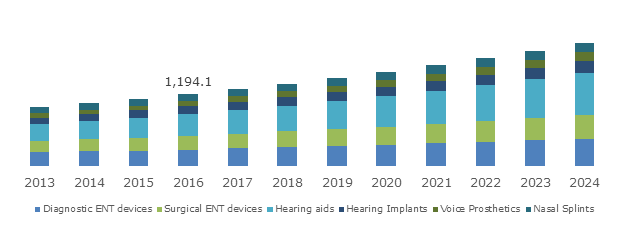
The abundance of contemporary innovations that ENT devices market is presently characterized by two major rationales. The primary one being the subsequent increase in the number of hearing impairments. According to World Health Organization, nearly 360 million people across the globe suffer from disabling hearing loss. In this regard, it is prudent to mention that the prevalence is quite strong in underdeveloped regions, where healthcare facilities are not that advanced. Secondly, the growing geriatric populace who are more vulnerable to various ear, nose and throat ailments are also bringing a slew of opportunities for ENT devices industry participants. In fact, the hearing loss is said to be the most prevalent in the age group of 60-69 years. Statistics further depict that nearly 2% of adults aged within 45 to 54 suffer from disabling hearing loss, whereas the proportion gets increased to 8.5% for adults with 55 to 64 years.
Speaking of the portfolio of ENT devices market, the business players have gained maximum profits from hearing aids. In fact, reports claim, hearing aids procured the maximum chunk of ENT devices industry share in 2016. With increasing number of hearing disorders worldwide, it goes without saying the percentage of authority is likely to continue. Numerous innovations with regards to this have already made their way to the front page, implying a positive growth trend for ENT devices industry share from the sales of hearing aids.
Get a Sample Copy of this Report@ https://www.gminsights.com/request-sample/detail/496
Just fresh-off-the boat, Blamey Saunders, one of the leading Melbourne based ENT devices market players received the prestigious Good Design Award of Australia in this year for its breakthrough device, Facett. The hearing aid device is featured with a core that is linked to an app. Powered by rechargeable batteries, Facett allegedly allows users to store one of the two pairs of modules in a small portable charging pod. If reports are to be relied on, it is claimed to be world’s first modular hearing aid, having pegged CSIRO Design Innovation Award for its outstanding architecture. An innovation of this degree undoubtedly marks exceptional advancements in ENT devices market over the recent years.
Given the fact that technology plays a pivotal role in this progressive pathway, U.S. undoubtedly experiences a strong command in the business space. The country garnered the title of procuring the largest ENT devices industry share in 2016. Below mentioned are some of the statistics that aptly define the remunerative portfolio of the U.S. in global ENT devices market:
- The NIDCD (National Institute on Deafness and Other Communication Disorders) claims that nearly 15% (37.5 million) of American adults aged 18 and above are detected with some kind of hearing trouble.
- Approximately 2- 3 out of 1000 children in the U.S. are born with detectable degree of hearing loss in one or both the ears.
- Nearly, 28.8 million adults in the U.S. are said to benefit from hearing aids usage.
- According to a report by Statista- the extensive prevalence of hearing loss nearly affects 10.6% of U.S. population.
Considering these statistics, it can be profoundly inferred that U.S. would continue to be a potential hotbed for ENT devices market investors. Speaking of the competitive landscape, product innovations would continue to be a major parameter defining the sustainability quotient of the market players. Regional governments are also making significant efforts in eliminating hearing, nose, throat ailments via various encouraging initiatives regarding noise pollution and subsequent hearing loss. All in all, inherently stimulated by a constantly upgraded product landscape in addition to governmental backings, ENT devices market is certainly one of the most captivating business spheres to watch unfold.
Author Name : Satarupa De
U.S. diabetic retinopathy market to attain substantial proceeds over 2017-2024, fueled by numerous regulatory initiatives
The growing prevalence of diabetes and its hazardous side-effects is one of pivotal factors responsible for diabetic retinopathy market expansion. Subject to sedentary lifestyles, in recent times, there has been a major rise in obesity, which has subsequently led to an increase in the number of diabetic issues. It has been observed that complications related to diabetes have been increasing massively, primarily on account of late diagnosis. In this regard, most of the regional governments are organizing awareness programs to encourage people to carry out eye screening tests for averting diabetic retinopathy, which would further demand appropriate treatment methods, pushing diabetic retinopathy industry share over the years ahead. The availability of artificial intelligence assisted healthcare services is also expected to impel diabetic retinopathy industry share, driven by the efficient and effective deployment of this technology for eye screening. As per estimates, diabetic retinopathy market share is expected to surpass USD 12 billion by 2025.
U.S. Diabetic Retinopathy Market Size, By Type, 2018 & 2025 (USD Million)
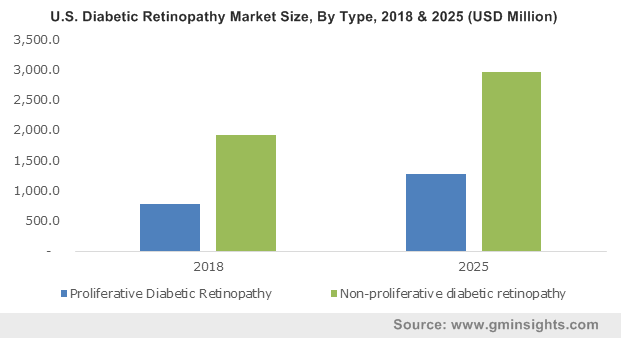
Vision loss stands as one of the most problematic health issues as on today. As per the CDC (Center for Disease Control and Prevention) vision problems accounted for USD 51.4 billion in treatments, for the United States on an annual basis. Yearly, around 12,000 to 24,000 new cases of blindness due to diabetic retinopathy occur in U.S. In consequence, the government is looking forward to deploying cost-effective and efficient screening tests for diabetic patients, which would undeniably fuel U.S. diabetic retinopathy industry share.
Speaking along the same lines, in first half of 2017, the FDA (Food and Drug Administration) also contributed majorly to U.S. diabetic retinopathy market share by approving the Lucentis (ranibizumab) injection for all kinds of diabetic retinopathy. Post the clinical trials, the analysis results depicted that 37.8% patients witnessed better improvement in diabetic retinopathy. Given that this is one of the most prominent causes of blindness across the U.S. among the working populace aged between 20 and 74, this approval has proved to be rather beneficial for diabetic retinopathy industry. The increasing demand for Lucentis injection for treating eye retina problems is cited to have a substantial impetus on diabetic retinopathy market share.
In order to deal with the increasing prevalence of blindness caused due to diabetic retinopathy, several players in diabetic retinopathy industry, in tandem with tech giants are investing heavily in software-based diagnosis methodologies. For instance, IDx, a medical device firm working on the development of software-based healthcare tools has invented an AI-based screening test for diabetic retinopathy. At present, it is under FDA clinical trial to obtain clearance for its use across U.S., post which it may bring about a revolution in U.S. diabetic retinopathy industry.
Get a Sample Copy of this Report:@ https://www.gminsights.com/request-sample/detail/486
In many countries though, where diabetic screening programs are not yet a reality, renowned tech giants and researchers are working continuously to introduce a series of screening programs. For instance, the research team of Google has developed an AI based diagnostic tool for detecting diabetic retinopathy, which is under clinical trial for being available across India. According to International Diabetes Federation, by 2045, India is predicted to have 134mn cases of diabetes, which is higher than the projected number of China (120 million). Undeniably, this would offer lucrative opportunities for participants in diabetic retinopathy market for business expansion across India.
Meanwhile, the escalating implementation of government approved fundraising and social welfare programs for blindness control has also been forecast to propel diabetic retinopathy market trends over the years ahead. Additionally, financial assistance from worldwide healthcare-related organizations such as WHO, DANIDA, and World Bank for the betterment of blindness programs will stimulate diabetic retinopathy industry trends. Driven by the increasing availability of advanced treatment facilities at the affordable prices, diabetic retinopathy market size will indeed chart out a lucrative path over 2019-2025.
Author Name : Sunil Hebbalkar
Government initiatives to curb cancer & development of novel biomarkers to encourage carcinoembryonic antigen market
Global Carcinoembryonic Antigen Market is set to register profitable growth in the near future and surpass USD 2.8 billion by 2023. This growth is attributed to factors including consistent technology advancements, development of novel biomarkers and growing prevalence of cancer. Global Market Insights, Inc. announces the addition of a new research report on Carcinoembryonic Antigen (CEA) market to their offering.
View a summary of the “Carcinoembryonic Antigen (CEA) Market Size, Industry Analysis Report” @ https://www.gminsights.com/industry-analysis/carcinoembryonic-antigen-cea-market
The report gives you a basic overview of the CEA market with market definition, applications, segmentation, and value chain analysis. The report covers competitive landscape with the leading company profiles and recent events in the industry. Equipped with all vital information including current scenario, forecasts, and future predictions, it offers insights to foresee challenges and opportunities that will aid in making informed decisions.
Growing demand for minimally invasive diagnostics procedures is projected to contribute a significant part in shaping market growth. Increasing geriatric population is another key factor to intensify the Carcinoembryonic Antigen market growth. The development of novel combination biomarkers and initiatives by the government concerning improved diagnostic rates are likely to open growth avenues for CEA market. The advent of various tumor markers, which can be used along with CEA to monitor or diagnose colorectal cancer is predicted to influence the market growth positively.
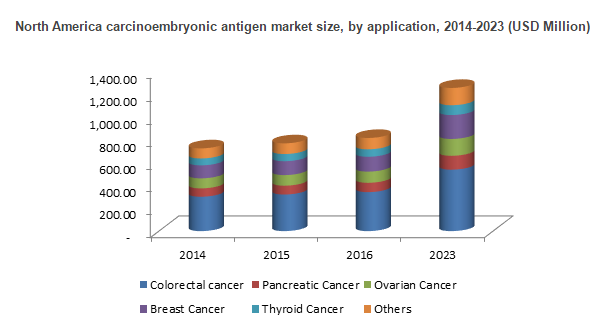
North America, hinged on the U.S. Carcinoembryonic Antigen market size, is predicted to lead the segment with estimations of USD 800 million in 2016. Growing awareness about detecting cancer at an early stage and improved health care services for cancer therapeutics are anticipated to propel growth. Asia-Pacific region driven by India and China is targeted to foresee growing prevalence of cancer owing to changes in lifestyle and aging population in the area. The growth is mainly attributed to improved treatment facilities and high disposable income. The Asia-Pacific market share can surpass USD 380 million in the near future.
Colorectal cancer tops the application segment and is expected to foresee growth over the forecast period. Breast cancer segment is likely to be the most lucrative with estimations of over USD 460 million at over 7% CAGR during the projected time frame.
Get a Sample Copy of this Report @ https://www.gminsights.com/request-sample/detail/427
The key players in global carcinoembryonic antigen market include
- Quest Diagnostics
- Roche Diagnostics
- GenWay Biotech, Inc.
- Abbott Diagnostics
Focus on early detection methods and product innovation owing to rising demand for minimally invasive procedures is a key strategy adopted by the key participants in the market.
Author Name : Dhananjay Punekar
Surge in demand for point of care analyzers to benefit blood gas and electrolyte analyzers
The new market research report by Global Market Insights Inc. estimates global Blood Gas And Electrolyte Analyzers Market size to grow at 4.8% from 2016 to 2023.
Strong product availability has helped improve the care of critically ill patients. Growing demand for highly developed sleek handheld devices with short turnaround time has led to the development of sleek, handy and more compact point-of-care devices. The report encapsulates market trends & issues, market profiling, growth drivers and inhibitors, opportunities and challenges, current industry overview, product innovations.
View a summary of the “Blood Gas and Electrolyte Analyzers Market Size, Industry Analysis Report” @ https://www.gminsights.com/industry-analysis/blood-gas-and-electrolyte-analyzers-market
The report covers:
- Current market scenario
- Market Estimates and Forecasts for 2016-2023
- Segmentation on the basis of product, region and competitive landscape
- Product Segments Analyzed in Volume and Value Terms
Growing geriatric population, prevalence of chronic end-of-life diseases, leading to high number of hospital admissions and increasing demand for health parameter monitoring devices are key factors contributing to blood gas and electrolyte analyzers market growth. A consequent rise in demand for high throughput and integrated systems is also likely to drive the market growth. Growing aging population is another key factor to impel the growth.
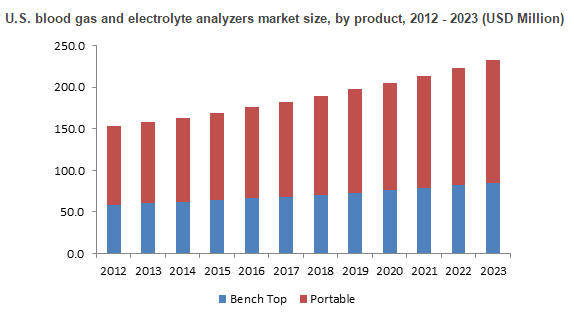
North America led by the U.S. blood gas and electrolyte analyzers market share dominates the regional market globally. APAC region driven by India and China tops the fastest growing market both in terms of volume and value. The region is projected to exhibit growth over 6.6% during the forecast period. The increase is attributed to rapidly developing healthcare infrastructure and changing dynamics of healthcare consumption. Furthermore, growing awareness about health is likely to influence the market growth positively.
LATAM market size is projected to witness a surge in coming years.
High impact factors rendering growth are
- Advent of new technology
- Prevalence of chronic diseases
- Growing number of patients in critical care and emergency departments,
- Increasing demand for blood gas testing
- Rising healthcare expenditure levels
- Growing preference shift towards point-of-care testing
- Emergence of multi-parameter monitoring devices
Portable analyzers lead the product segment and are likely to continue dominance over the predicted time frame. Combined analyzers are expected to witness significant growth at 5.5% CAGR over the next few years.
Get a Sample Copy of this Report @ https://www.gminsights.com/request-sample/detail/428
Major participants in global blood gas and electrolyte analyzers market include:
- Cerner Corporation
- Roche Diagnostics
- Alera Medical
- Siemens Healthcare
- Instrumentation Laboratories, Inc.
Merger and acquisition and strategic collaboration are the key strategy to focus on to achieve product portfolio expansion and maintain leading position.
Author Name : Dhananjay Punekar
Contraceptives market revenue to be perpetually driven by the massive contribution of regional governments toward population control over 2017-2024
The exponentially growing popularity of birth control methods to reduce the risk of unintended pregnancies is likely to drive contraceptives market in the years ahead. The critical acclaim that contraceptives have gained recently is quite evident from the robust sales of contraceptive implants and intrauterine contraception methods, that are being prominently utilized, pertaining to their effectiveness. Considering the role contraceptives play in population control, many of the regional governments have been organizing awareness programs for recommending their usage. Even the CDC for instance, has updated some of its guidelines for contraceptives with a few upgraded recommendations for healthcare providers. The aforementioned details provide evidence to the fact that stringent clinical guidelines outlined for healthcare suppliers will reduce barriers for contraceptive usage and access, which would eventually fuel contraceptives industry share over the years ahead. Numerous regulatory bodies have also been undertaking initiatives to educate people regarding the usage and benefits of contraceptives. For instance, WHO (World Health Organization) promotes family planning by providing guidelines on service delivery and the safety of contraceptive methods, supplying pre-qualification of contraceptive commodities, and helping countries to adopt & implement these facilities to fulfill their requirement.
Germany Contraceptives Market, By Drugs, 2013-2024 (USD Million)
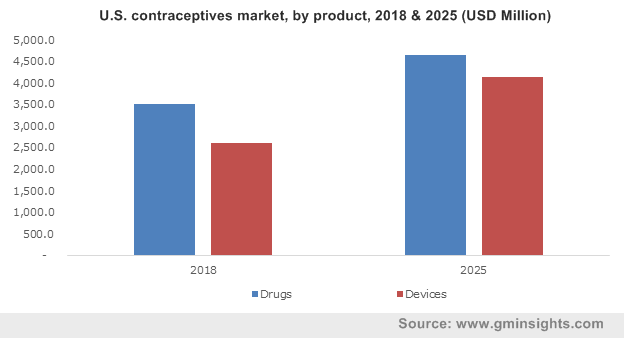
Citing another instance of the vital role that regulatory bodies play in the growth of contraceptives market, it is prudent to mention that recently, the Philippines Department of Health (DOH) announced that it would buy contraceptives worth 200 million pesos. Through this purchase, the government apparently aims to manufacture pills and other contraceptives in order to overcome the current shortage and fulfill the demand for family planning products in the ensuing years. The initiative undertaken by the Philippines DOH takes precedence in contraceptives market, validating the fact that the prevalence of family planning policies and government programs is likely to stimulate Asia Pacific contraceptives market share over the years ahead.
Get a Sample Copy of this Report:@ https://www.gminsights.com/request-sample/detail/430
Speaking of Asia Pacific, the sub-continent of India falls among the list of countries that is currently over-populated. The population of the country, as of 2016, is reportedly over 1.3 billion. On these grounds, the Indian government has implemented several social programs to deliver contraceptives directly to communities. The government has also made efforts to recruit Accredited Social Health Activists (ASHAs) for delivering contraceptives at the doorstep. Many programs so far, have apparently witnessed enormous success, positively influencing community-based family planning, which would eventually boost India contraceptives industry trends.
Currently, numerous contraceptives market giants and regulatory bodies have been striving to bring about a transformation in the product landscape of this business sphere. The Food and Drug Administration (FDA) for instance, has revealed a list of 51 contraceptives for re-certification based on the parameters of safety and non-abortifaciency. Even in the U.S., the California Health Benefits Review Program (CHBRP) has enforced a federal contraceptive mandate – the Affordable Care Act (ACA). On these grounds, the Trump administration has released two interim rules related to ACA’s contraceptive coverage requirement, which would provide a boost to U.S. contraceptives market trends. Considering the strict outlook that regulatory bodies have toward newly developed products, contraceptives industry players such as Merck & Co., Pfizer, Mayer Laboratories, Cooper Surgical Inc., Teva Pharmaceutical Industries, Actavis, Reckitt Benckiser, and Church & Dwight Co. have also been heavily investing in research and development activities, thereby impelling this business sphere.
Numerous other geographies across the globe have also been making efforts toward population control, impacting contraceptives market share by extension. The South African government for example, deploys several development policies such as population development programs, family planning programs, and fertility regulations which has been considerably affecting product demand. The robustly rising awareness regarding the ever-growing population is thus slated to propel contraceptives industry size, forecast to exceed USD 35 billion by 2024.
Author Name : Author – Sunil Hebbalkar
Growing prevalence of deafness coupled with an expanding global geriatric population base to drive audiology devices market growth
Audiology devices market, thriving on the cusp of digital interventions, has witnessed remarkable proceeds over the past decade. Introduction of DSP (Digital Signal Processing) in hearing systems has been heralded with great expectations and acclaim. With better fidelity and improved performance, modern day’s digital hearing aids claim to offer greater restoration for a wide range of perplexing auditory deficits. Needless to mention, companies partaking in audiology devices industry are leaving no stone unturned to exploit the maximum potential of this technology. Starkey’s recent launch of Muse iQ Rechargeable 900sync™ is an apt evidence of the same.
Germany Audiology Devices Market, By Product, 2013 – 2024
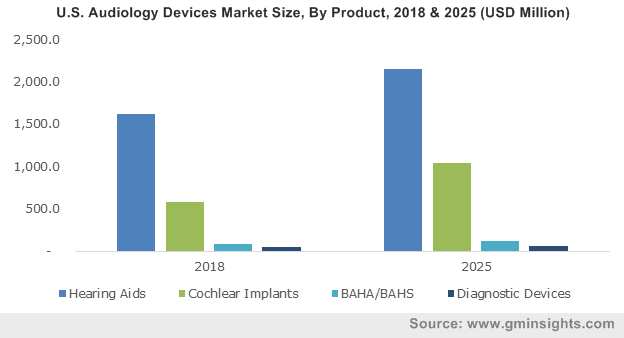
Elaborating further, Muse iQ Rechargeable that has been unveiled by Starkey Hearing Technologies in the beginning of this year is claimed to be world’s smartest and smallest hearing aid. Based on the company’s flagship Acuity™ OS operating system and award-winning Synergy® platform, this breakthrough hearing aid offers high-definition clarity, sound, and presence. While Starkey’s deep-rooted stance in audiology devices industry in not unheard of, bringing market’s smallest technology enabled hearing solution is certainly a breakthrough of sorts. As claimed by sources, this groundbreaking technology was launched at Starkey’s Hearing Innovation Expo based in Las Vegas.
Get a Sample Copy of this Report:@https://www.gminsights.com/request-sample/detail/426
It is undeniable that hearing aids are the most convenient clinical intervention for hearing deficiencies, subject to which it has procured maximum of the audiology devices industry share in 2016. However, it has been observed that recent technological advancements have led to an increasing deployment of alternative hearing devices. Growing awareness and utilization of cochlear implantation (CI) can be majorly attributed to this fundamental aspect, driven by its cost-effective outcome-based solutions.
It is imperative to mention here that the utilization rate of cochlear implantation in major part of the world is higher for children than geriatric populace. The trend is synonymous for the U.S. audiology devices market where the utilization rate among children having appropriate audiological profile is nearly 50%. Whereas it is less than 5% for the adult profile. When being surveyed on a much larger base of adults than children who suffer from profound hearing loss, it has been observed that cochlear implantation surgeries in the country cover 60% adults and 40% children. Despite the fact that this technology has received FDA approval long back, experts believe dearth of proper awareness campaigns is somewhat hindering its full-fledged optimization in audiology devices market.
Nonetheless, the ongoing research activities is certain to open new doors of opportunities for audiology devices market, through which unconventional hearing device manufacturers seem to garner profits. Add to it, growing geriatric populace vulnerable to hearing deficits is bound to create massive demand for product innovation in the marketplace. In this regard, experts claim, implementation of stringent regulatory norms related to hearing devices will have a significant impact on the product development. In terms of profitability potential, Global Market Insights, Inc. forecasts audiology devices industry size to surpass USD 10 billion by 2024.
Author Name : Satarupa De
- ← Previous
- 1
- …
- 21
- 22
